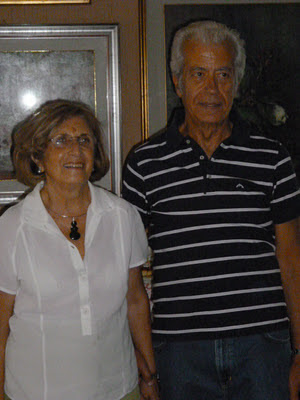We woke up on several mornings to find cars, pavements and houses covered in fine black dust (actually glass), and there was an almost permanent haze in the Naxos/Taormina air from Etna's breath.
 |
| The beach in Naxos, 2 minutes walk away from our 'bach'. |
Visiting the Valley of the Temples was a long drive, but very worth while. Here lie the ruins of ten Greek temples that at one time were the rival of Athens. Some are partially restored, but every one has a presence all the more poignant because they are juxtaposed against a distant background of high rise housing.
Another interesting juxtaposition is the placing of some stunning modern bronze sculptures scattered among the temples.
Another reason why this day was memorable is that I tasted real squid ink sauce for the first time - don't know why I've not tried it before, after all other great foods are black - like truffles. Oh my goodness, the flavour! Squid ink (Nero di Seppia) is not at all fishy but is perhaps best described as tasting of sea and umami. In any case, I've already put in an order to Sabato back home. . . I loved it, just hope I can recreate that flavour!
Whole marinated and grilled squid were a triumph, too - it's seafood heaven in this place; squid, octopus, mussels, and of course swordfish (marlin).
Away from the beaches you could be in a different country, and it's well worth while exploring some of the villages in the more inaccessible parts of the interior, as well as villages like Savoca, where 'The Godfather' was filmed.
One of the absolute treasures of our week in Sicily was to be invited with our friends, Terry and Anne, to our host's home for lunch. Betti loves to cook and we'd already been advised that if Betti and Franco invite you for lunch, never under any circumstance turn it down. This turned out to be a great truth.
 |
| Betti & Franco |
We've found the Italian people are, in general, very friendly, have a natural courtesy and a great sense of humour. In the case of Betti and Franco, they are also overwhelmingly generous and hospitable. This was no ordinary lunch.
First, there was a selection of appetisers
 |
| Skewered black and green grapes with cheese, baby tomatoes stuffed with ricotta and herbs |
 |
| Foccacia with delicious home made sundried tomatoes |
 |
| A fingerfood quiche/pie, with onion and a bechamel sauce |
 |
| Betti's sister Rina, who with Franco was Betti's support team |
Next, the pasta course; Betti made Pasta Norma, a penne with home made tomato sauce; sister Rina made a fresh anchovy, fennel, and tomato sauce, garnished with coconut thread. The Pasta Norma was delicious, and I thought the anchovy/fennel/tomato was a great flavour combination.
 |
| Pasta Norma and penne with fresh anchovy, florence fennel, tomato and a coconut garnish |
Franco then dished up baked swordfish rolls topped with toasted breadcrumbs and accompanied by a caponata; a lovely combination of flavour, colour and texture.
 |
| Silver service, of course |
 |
| Baked swordfish rolls, with caponata |
I have to try to get hold of Betti's lemon sorbet recipe, it's the best I've ever tasted, and was served as a palate freshener after the fish.
And then, just to round off, was a superb grape and custard tart
And yes, I did eat it all. Needless to say, though, none of us were hungry again until after well into the night, and even then we didn't need much. Wonderful food, lovely people and what a treat to experience Sicilian hospitality like this.









































